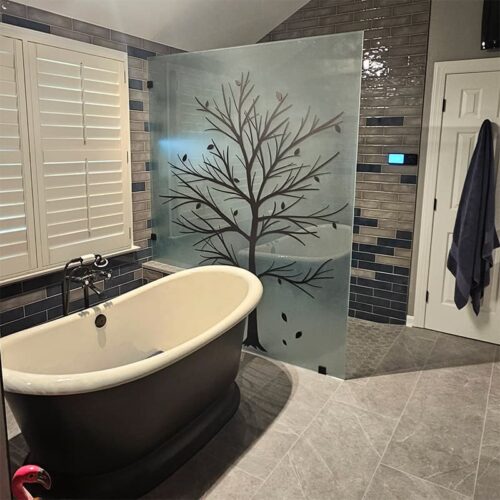How early planning with your glass partner can prevent headaches and boost project value
 When you’re managing timelines, budgets, and subs, glass probably isn’t the first thing on your mind. But getting it right can make or break a project visually, structurally, and logistically.
When you’re managing timelines, budgets, and subs, glass probably isn’t the first thing on your mind. But getting it right can make or break a project visually, structurally, and logistically.
The best general contractors and architects we work with have one thing in common: they think about glass early. That foresight helps them stay on schedule, avoid mid-build surprises, and impress clients with spaces that look polished and perform beautifully.
Here are five questions we recommend asking during pre-construction to keep your next build on track and your clients happy.
1. What will the glass need to do?
Why it matters: Every glass application requires different fabrication specs. Structural glass panels, railings, steps, doors, decorative partitions, and safety glazing each have unique performance requirements, and waiting until installation to figure that out leads to delays and budget overages.
Specifying the function early helps you choose the correct glass thickness, tempering, and edge finish while ensuring compliance with building codes and safety regulations. It also lets your fabricator plan for complex needs like laminated or fire-rated glass, which often have longer lead times.
Ask this early to:
- Avoid last-minute code changes;
- Choose the right glass specs for performance and safety; and
- Ensure the finished product matches the intended use.
2. What finishes or hardware will the glass interact with?
Why it matters: Glass doesn’t exist in isolation. It connects with hinges, clamps, U-channels, or custom millwork, and those connections can affect structural integrity and visual appeal.
Coordinating early ensures your cutouts, notches, and holes are correctly placed before tempering, which saves costly reworks. This is especially critical in frameless shower enclosures, glass railings, or custom office partitions where tolerances are tight and finish alignment is essential.
Ask this early to:
- Prevent mismatches between hardware and panel specs;
- Avoid reordering glass that doesn’t align with its mounts; and
- Keep the installation process safe, smooth, and efficient.
3. Will lighting or surrounding materials affect the glass look?
Why it matters: The materials and lighting around a glass panel dramatically affect how it looks. Standard clear glass has a natural green tint that can distort colors behind it, especially in bathrooms with white or light-colored tile, or in retail displays with colored backlighting.
Understanding how low-iron vs standard glass and bent glass vs straight glass performs helps you make better design decisions. Low-iron glass offers a more neutral, ultra-clear appearance and is ideal for luxury interiors, modern bathrooms, and commercial showcases where clarity matters. Bent glass adds a unique look and requires different lighting setups due to the manner in which it refracts light, always to great impact.
Ask this early to:
- Preserve true color and material accuracy in finished spaces;
- Choose the right type of glass to match your design intent; and
- Offer clients premium visual results without unexpected surprises.
4. Are there branding or customization opportunities?
Why it matters: Architectural glass can do more than divide space—it can communicate brand identity or enhance design impact. Whether through etched logos, frosted privacy bands, screen printing, or backpainting, these upgrades transform standard panels into visual centerpieces.
Clients in hospitality, healthcare, and retail often look for ways to make a space feel unique. Custom decorative glass can become a selling point, elevating your bid without major cost increases when planned from the start.
Ask this early to:
- Incorporate visual upgrades without disrupting timelines;
- Differentiate your project with easy, high-impact features; and
- Help clients achieve design goals with minimal effort.
5. How will this glass be fabricated, shipped, and installed?
Why it matters: Large or custom glass panels require precise logistics. Improper timing, poor packaging, or missed staging windows can result in broken panels, costly delays, or installation issues.
By coordinating fabrication and delivery with your build schedule, you’ll ensure the right glass arrives at the right time, reducing risk and keeping your jobsite efficient. Clearlight offers project staging, labeling, and coordination to help contractors and designers avoid last-minute issues.
Ask this early to:
- Confirm glass sizes and fragility are install-ready;
- Align delivery with project phases and install windows; and
- Avoid rush fees, damaged goods, or project slowdowns.
Pre-Construction Glass Checklist for GCs and Designers
Use this quick list during planning meetings to keep glass moving forward, without surprises.
Need help working through these questions?
Clearlight Glass has 25+ years of experience supporting builders and designers at every stage of the project.
Let’s talk early, so your glass works the way it’s supposed to—on day one.